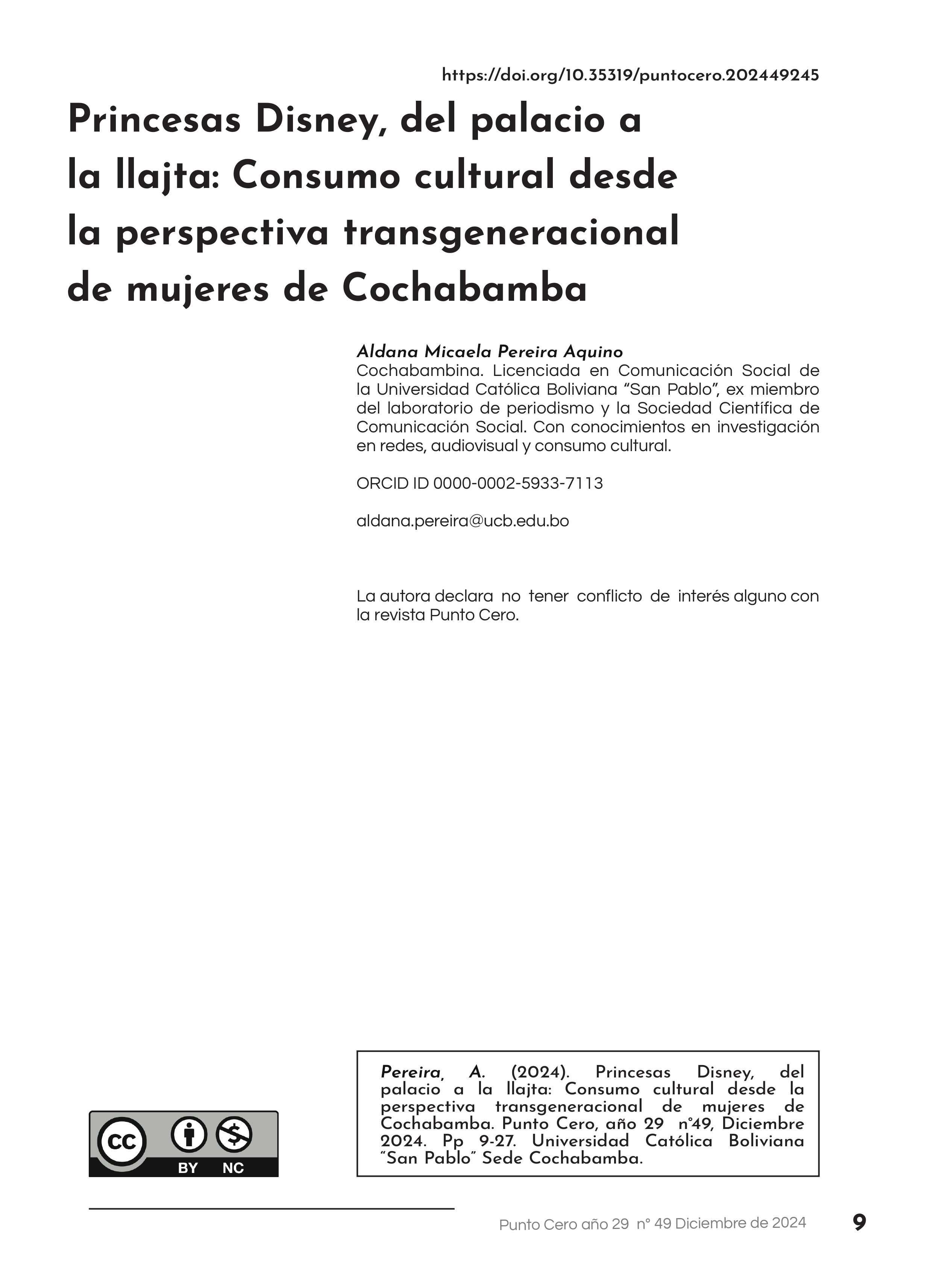Disney princesses, from the palace to the llajta: Cultural consumption from the transgenerational perspective of women from Cochabamba
DOI:
https://doi.org/10.35319/puntocero.202449245Keywords:
Disney Princesses, Cultural consumption, Transgenerational perspective, Archetypes, FemininityAbstract
This research has the purpose of determine how is the cultural consumption of the representation of the main characters of “Cinderella, Mulán and Frozen” since the transgenerational perspective of women from Cochabamba. For it, through discussion groups and interviews, it is established the speech that mothers and daughters create about the narratives and finally it is determined how they integrate the princess characteristics at their own realities. It is discovered that the main characters share aspects as kindness, compassion or beauty, but also they show different personalities that not only fit in the damsel in distress archetype, but also with the adventuress, free spirits, and the protector ones. Taking this into account, women have formed a mixed discourse on the narratives, identifying positive and negative aspects. In this way, by consuming these products at different stages of their lives they have perceived that they are reflected in their personalities, motivations and some actions, showing that there are different types of femininity and that gender roles are just labels that limit human complexity.
References
Aguado Peláez, D., & Martínez Garcia, P. (2015). ¿Se ha vuelto Disney feminista? Un nuevo modelo de princesas empoderadas. Área Abierta, 15(2), 49–61. https://doi.org/10.5209/rev_arab.2015.v15.n2.46544 DOI: https://doi.org/10.5209/rev_ARAB.2015.v15.n2.46544
Ahenke, A. (2023). Entrevista sobre consumo de la películas de Disney Princesas.
Alvarez, V. (1989). Los grupos de discusión. Cuestiones Pedagógicas: Revista de Ciencias de La Educación, 6.
Bancroft, T., & Cook, B. (1998). Mulán. Walt Disney Studios.
Barrantes Echavarría, R. (2002). Investigacion: un camino al conocimiento. Un enfoque cualitativo y cuantitativo. In Euned (p. 60).
Buck, C., & Lee, J. (2013). Frozen. Walt Disney Studios.
Camacho, M. R. (2023). Entrevista sobre consumo de las películas de Disney Princesas.
Canales, M., & Peinado, A. (1994). GRUPOS DE DISCUSIÓN. In Métodos y Técnicas de Investigación en Ciencias Sociales (pp. 287–316).
Cantero, P. C., & Wolf, N. (1994). El mito de la belleza. Reis, 68, 254. https://doi.org/10.2307/40183772 DOI: https://doi.org/10.2307/40183772
De Beauvoir, S. (1953). The Second Sex. In Yale French Studies (Issue 27). https://doi.org/10.2307/2929315 DOI: https://doi.org/10.2307/2929315
Díaz Cedillo, P. (2022). Cinderella (La Cenicienta). Walt Disney (1950). Un análisis cinematográfico. (Issue 1950). Universidad de Valladolid.
Geromini, C., Jackson, W., & Luske, H. (1950). Cenicienta. Walt Disney Studios.
Grupo Focal. (2023). Grupo Focal Frozen.
Grupo Focal Cenicienta. (2023). Grupo Focal Cenicienta.
Grupo Focal Cenicienta virtual. (2023). Grupo Focal Cenicienta.
Grupo Focal Frozen. (2023). Grupo Focal Frozen.
Grupo Focal Mulán. (2023a). Grupo Focal Mulán.
Grupo Focal Mulán. (2023b). Grupo Focal Mulán.
Guardia, M. (2021). Mundos de referencialidad: el entorno comunicacional contemporáneo (1st ed.). Universidad Católica Boliviana “San Pablo.”
Hooks, B. (2000). Feminism is for everybody (Vol. 79, Issue 5). https://doi.org/10.4324/9781315743189-3 DOI: https://doi.org/10.4324/9781315743189-3
Kuhn, A., & Radstone, S. (1990). The Women’s Companion to International Film. https://books.google.com.bo/books/about/The_Women_s_Companion_to_International_F.html?id=pjqOM04aGJ8C&redir_esc=y
Lezcano, P. (2021). ANÁLISIS DE ARQUETIPOS EN PRINCESAS DISNEY Y REINTERPRETACIÓN MEDIANTE EL FANDUB. TecnoCampus Escola Superior Politécnica.
Martín-Barbero, J. (1991). De los medios a las mediaciones.
Martín-Barbero, J. (2002). Pistas para entre-ver medios y mediaciones. Signo y Pensamiento, 21, 13–20.
Méndez, A. I. (n.d.). Metodologías y técnicas de investigación aplicadas a la comunicación.
Ricondo Ancín, A. (2017). La imagen de la mujer en los clásicos Disney.
Rogers, A. (2020). Are Disney Characters ‘Frozen’’ in Stereotypes? An Intersectional Analysis of Frozen.’ Education Sciences and Society, 2, 23–41. https://doi.org/10.3280/ess2-2019oa8427 DOI: https://doi.org/10.3280/ess2-2019oa8427
Taylor, S. L., & Bogdan, R. (1984). Introducción a los métodos cualitativos de investigación. Paidós.
Tejerina, M. (2023). Entrevista sobre consumo de las películas de Disney Princesas.
Vicens Poveda, A. (2019). Heroínas o princesas: análisis de la evolución de los personajes de la marca" Princesas Disney" desde su posible superación de los estereotipos sexistas, dentro y fuera de la ficción animada. In Ene (Vol. 12).
Vogler, C. (2002). El viaje del escritor (Robinbook (ed.)).
Wu, Y. (2020). The Analysis of Elsa’s Growth from the Perspective of Ecofeminism. Open Journal of Social Sciences, 08(06), 30–36. https://doi.org/10.4236/jss.2020.86003 DOI: https://doi.org/10.4236/jss.2020.86003

Downloads
Published
How to Cite
Issue
Section
License
Copyright (c) 2024 Revista Punto Cero

This work is licensed under a Creative Commons Attribution-NonCommercial 4.0 International License.








